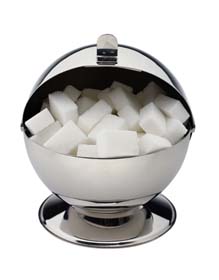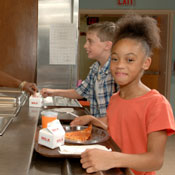
By Ed Bruske
aka The Slow Cook
"Healthy Schools" legislation written by D.C. Councilmember Mary Cheh comes up for its first committee vote today after months of deliberations and with one very conspicuous missing element: no regulation of sugar in school meals.
Removing the astonishing amount of sugar served to D.C. school children every day is probably the quickest and cheapest way to make school meals healthier. But you won't see any of that in the "Healthy Schools" legislation. How can that be, you might ask, when kids are being served
15 or more teaspoons of sugar every day for breakfast at school: strawberry milk the equivalent of Mountain Dew, candied cereals containing three or more teaspoons of sugar per serving, Pop-Tarts, juices that might as well be sodas.
A teaspoon of sugar contains 16 calories, meaning the breakfast described above contains 240 calories worth of sugar, or 44 percent of the 550 calories the "Healthy Schools" bill sets as the maximum total breakfast calories D.C. school children through eighth grade should be consuming.
Truth is, federal regulations that govern school food programs contain no limits on sugar in subsidized meals. Consequently, according to a top legislative aide involved in writing the "Healthy Schools" bill, there were no standards on which to base a limit on sugar for meals served in the Distict of Coumbia.
"We certainly have heard the concerns that you and others have expressed about sugar in school meals, but we haven't seen any guidance about how to regulate it," the aide said. "Neither the HealthierUS [School Challenge] nor the IOM [Institute of Medicine] standards have recommendations for limiting sugar in school meals. (The IOM notes, on page 52, that "By far the largest contributors to the intakes of added sugars (45 percent of the total amount) were regular soda and noncarbonated sweetened drinks," which are heavily restricted under the HSA.) Therefore, there does not seem to be any guidance about how to do it."
The American Heart Association last year issued
specific guidelines on consumption of added sugars for adults, but not for children. For instance, the AHA recommended that "moderately active" women consume no more than five teaspoons--or 80 calories--of added sugar per day. That would rule out much of the food children are served daily in D.C. schools.
And what about flavored milk served at breakfast and lunch in D.C. schools? Chocolate milk contains the same amount of sugar as Classic Coke, and strawberry milk nearly as much as Mountain Dew. The strawberry milk contains 28 grams of sugar--about seven teaspoons, three of which occur naturally as lactose--or 112 calories. That represents 66 percent of the 170 total calories in the one-cup containers routinely handed out in D.C. schools for breakfast and lunch.
"Regarding flavored milk, we do understand your concerns, but we have also heard concerns from other nutritionists who say that milk is important for child development and that even if the milk is flavored it is better for children to drink flavored milk than to drink no milk at all," the aide said. "We are not nutritionists and have no way to resolve this debate. Therefore, we are choosing to use this bill to set the floor for school nutrition and then to empower OSSE [Office of the State Superintendent of Education] and schools to set higher standards -- to ban flavored milk and other things if they so choose."
In fact, there is no scientific body of evidence indicating that children who are not offered a flavored milk option either drink less milk or are deprived of important nutrients. That seems to be more of an assumption encouraged by the dairy industry, which counts on flavored milk for a large portion of its sales.
Still, how can it be that the federal meals program, in existence since 1946, has no standard to govern the use of sugar in school meals, especially at a time when child obesity and attendant diseases such as diabetes are such a concern? I asked Marion Nestle, a prominent nutritionist and author of
Food Politics.
"Here’s the short answer: Sugar industry lobbying," Nestle said.
"And here’s a bit more:
"Sugars were never a problem when schools were reasonably well supported in part because competitive foods were reasonably well regulated and in part because snacks were too. All that changed when schools ran out of money and had to start pushing snacks and sodas in order to fill the budget gap. Nobody paid much attention to what kids were eating—until recently.
"No federal agency has ever set a maximum for sugar intake although dietary advice for years all over the world has been to limit sugars to 10% or less of daily calories. That percentage was embedded in the recommendations of the 1992 USDA Pyramid which said, “Use sugars only in moderation.” USDA defined “moderation” as 6 teaspoons a day of total added sugars for a diet containing 1600 calories, 12 tsp for 2200, and 18 tsp for 2800. If you do the math (assume that a tsp is 4 grams and 16 calories), this comes to less than 10% of daily calories. But the Pyramid did not say so explicitly. That’s just how it works out.
"Some years later, in developing the new Dietary Reference Intakes, the Institute of Medicine recommended 25% of calories from added sugars as an upper limit.
"In the early 2000s, the World Health Organization attempted to set an upper limit of 10% of calories from added sugars to its global strategy for health. U.S. sugar lobbying groups went berserk and got the attorney for the Department of Health and Human Services to write a letter to WHO threatening to withdraw U.S. funding if that recommendation was not eliminated. The controversial figure disappeared.
"The bottom line: no standard of intake exists so anything goes. My understanding is that sugars not only pervade the meals, but also treats given out by teachers and brought in by parents for birthdays.
"The one bright side is that the reauthorization of the Child Nutrition Act contains provisions to revisit the standards for school meals based on the Dietary Guidelines that will be coming out later this year. These, hopefully, will refer to a recent IOM report developing new school meals standards for the USDA."
The IOM found that children's consumption of "discretionary" calories from solid fat--as from hamburgers and pizza--and sugar "were much higher than the amounts specified" by the federal food pyramid. For children aged nine to 13, for instance, the excess averaged 543 calories, or about a third of the total daily calories recommended for children in that age group.
But rather than address sugar directly, the IOM panel took a back-door approach: increasing the amount of "healthy" foods in school meals and setting a maximum on calories served in school meals would drive down the amount of calories from sugar, the panel reasoned. "The committee notes that its approach to developing the standards for menu planning leaves relatively few discretionary calores for added sugars and saturated fat," the report reads.
But with "careful menu planning," the panel suggests, schools would still have enough of those discretionary calories to make room for flavored milk and sugary cereals. "The ommission of those sweetened foods might result in decreased student participation as well as in reduced nutrient intakes."
Nestle calls this last statement by the IOM committee "a sellout. I’ve been in plenty of schools where the kids eat unsweetened foods and are doing just fine. Those schools are run by adults who care what kids eat. Kids will eat foods prepared by adults who care, as witnessed by Jamie Oliver."
Although Cheh's original "Healthy Schools" bill embraced the proposed IOM standards, she abandonned them after school officials said they could not guarantee schools would be able to serve additional vegetables that kids would actually eat and not throw in the trash. The bill now adopts less stringent standards under the "HealthierUS Schools Challenge" sponsored by the USDA. Those standards likewise do not address the issue of sugar in school meals.
Nestle said the best hope may be if Congress, in its pending re-authorization of the Child Nutrition Act, requires that schools adhere to the government's own Dietary Guidelines for Americans. Those call for no more than two to eight teaspoons of sugar per day for discretionary calories, according to Nestle.
"The USDA [food] Pyramid allows 200-300 discretionary calories a day for fats and sugars. That’s less than 10% of calories, and still not bad," Nestle said.

 They say that what kids bring from home often is worse than what's served at school. One 10-year-old girl got this "Go Cola" out of her backpack. The 12-ounce can contains 44 grams of sugar--11 teaspoons--or 176 calories. That's five teaspoons more "added" sugar than the American Heart Association recommends as the maximum a grown woman should consume in an entire day.
They say that what kids bring from home often is worse than what's served at school. One 10-year-old girl got this "Go Cola" out of her backpack. The 12-ounce can contains 44 grams of sugar--11 teaspoons--or 176 calories. That's five teaspoons more "added" sugar than the American Heart Association recommends as the maximum a grown woman should consume in an entire day.









































